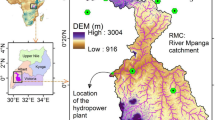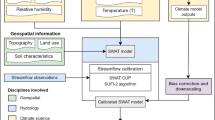Abstract
Global policies for mitigation of global warming GW will require countries to rely as possible upon renewable, clean energy sources. This includes developing countries, in need to foster suitable life conditions under population growth. Hydropower can deliver such renewable energy, pending water availability and proper management. In central Asia, water resources management is an urgent challenge, especially given desert climate, and the expected impacts of transient climate change hereon. While some catchments will still receive large shares of water from transient melting of the water towers in the Himalayas, others will not, given their little ice cover, in spite of the high altitudes. This is the case of Kabul River of Afghanistan, displaying low rainfall and high altitude, and yet displaying very small ice cover, and where further the present hydropower network is limited and partly damaged by recent conflicts. The goal of this work is to evaluate hydropower potential of the Kabul River and subsequently potential hydropower coverage of energy demand, under the hypotheses that (i) the present network would work at its largest potential and (ii) that hydrological regimes will change in response to scenarios of climate change, until the end of XXI century. To do so, we use a sparse array of data to tune the Poli-Hydro model, able to model hydrology of high altitude, poorly monitored catchments as here. Using modelled (and otherwise unknown) streamflows entering the present power plants (reservoirs + power-houses), we then simulate water management for hydropower purposes. We use two conditions, namely (i) run-of-river ROR and (ii) storage, and (optimal) regulation STO, allowing multipurpose use of water when necessary (e.g. irrigation needs). We then feed Poli-Hydro with IPCC climate scenarios (plus downscaling) until 2100, to carry out a sensitivity analysis (what if? scenarios) of (i) hydrological cycle and (ii) hydropower production. The future hydrological regimes are largely affected by uncertain future precipitation, and so is hydropower production. In spite of potentially increased hydropower on average (+ 1.4% at mid-century, + 1.7% at 2100), driven by variably changing stream flows, some scenarios indicate decreased overall production (down to − 3%) at half century. We provided here a tool usable to (i) assess present and future hydropower potential in the Kabul River, (ii) direct improvement of the present plants network and (iii) benchmark proposals for future network extension.











Similar content being viewed by others
References
Afghanistan Spatial Data Center (2019) A web-based geospatial platform developed by iMMAP as part of the USAID-Funded Disaster Risk Reduction. https://immap.org/product/afghanistan-spatial-data-center-asdc/
Aggregated Land Cover Database of the Islamic Republic of Afghanistan (2010). https://www.humanitarianresponse.info/sites/www.humanitarianresponse.info/files/afg_landcover_201403MAR23_A3.pdf
Aili T, Soncini A, Bianchi A, Diolaiuti G, Bocchiola D (2018) A method to study hydrology of high altitude catchments: the case study of the Mallero River, Italian Alps. Theor App Climatol:1–22
Akbari-Alashti H, Soncini A, Dinpashoh Y, Fakheri-Fard A, Talatahari S, Bocchiola D (2018) Operation of two major reservoirs of Iran under IPCC scenarios during the XXI century. Hydrol Process 32(21):3254–3271
Alexander L (2013) Summary for policymakers. Stocker T F et al (Eds) Climate change 2013: The physical science basis 3–29
Arfan M, Makhdum AH, Nabi G (2017) Assessment of temporal flow variability of the Kabul river. J Mountain Area Res 2:1–8
Bocchiola D, Diolaiuti G (2013) Recent (1980–2009) evidence of climate change in the upper Karakoram, Pakistan. Theor Appl Climatol 113(3–4):611–641
Bocchiola D, Rosso R (2007) The distribution of daily snow water equivalent in the central Italian Alps. Adv Water Resour 30(1):135–147
Bocchiola D, Rosso R (2009) Use of a derived distribution approach for flood prediction in poorly gauged basins: a case study in Italy. Adv Water Resour 32(8):1284–1296
Bocchiola D, Diolaiuti G, Soncini A, Mihalcea C, D'agata C, Mayer C, Smiraglia C (2011) Prediction of future hydrological regimes in poorly gauged high-altitude basins: the case study of the upper Indus, Pakistan. Hydrol Earth Syst Sci 15(7):2059–2075
Bocchiola D, Soncini A, Senese A, Diolaiuti G (2018) Modelling hydrological components of the Rio Maipo of Chile, and their prospective evolution under climate change. Climate 6(3):57
Bocchiola D, Brunetti L, Soncini A, Polinelli F, Gianinetto M (2019) Impact of climate change on agricultural productivity and food security in the Himalayas: a case study in Nepal. Agric Syst 171:113–125
Bookhagen B, Burbank DW (2010) Toward a complete Himalayan hydrological budget: spatiotemporal distribution of snowmelt and rainfall and their impact on river discharge. J Geophys Res Earth Surf 115(F3)
Carius A, Maas A (2009) Climate change and security: three scenarios for Middle America. European Commission, Brussels
Casale F (2018) Potenziale idroelettrico in Afghanistan ed effetti dei cambiamenti climatici: il progetto ElettriKabul. [Hydropower potential in Afghanistan and effects of climate change therein: the ElectriKabul project]. MS Thesis, a.y. 2017-2018. Mat. 878286. Politecnico di Milano. In Italian
Da Afghanistan Brishna Sherkat DABS (2013) Afghanistan Energy Sector Overview. https://eneken.ieej.or.jp/data/5015.pdf
Forsythe N, Fowler HJ, Blenkinsop S, Burton A, Kilsby CG, Archer DR, Hashmi MZ (2014) Application of a stochastic weather generator to assess climate change impacts in a semi-arid climate: the Upper Indus Basin. J Hydrol 517:1019–1034
Frischmann P, House B, Park P, Lane R (2013) Afghanistan resource corridor development: water strategy - final Kabul river basin report: version 4.0. World Bank
Gent PR, Danabasoglu G, Donner LJ, Holland MM, Hunke EC, Jayne SR, Zhang M (2011) The community climate system model version 4. J Clim 24:4973–4991
Groppelli B, Soncini A, Bocchiola D, Rosso R (2011a) Evaluation of future hydrological cycle under climate change scenarios in a mesoscale Alpine watershed of Italy. Nat Hazards Earth Syst Sci 11(6):1769–1785
Groppelli B, Bocchiola D, Rosso R (2011b) Spatial downscaling of precipitation from GCMs for climate change projections using random cascades: a case study in Italy. Water Resour Res 47(3)
Hazeleger W, Wang X, Severijns C, Ştefănescu S, Bintanja R, Sterl A, Van der Wiel K (2011) ECEarth V2.2: description and validation of a new seamless earth system prediction model. Clim Dyn 39:2611–2629
Hock R (2003) Temperature index melt modelling in mountain areas. J Hydrol 282(1–4):104–115
Im ES, Pal JS, Eltahir EA (2017) Deadly heat waves projected in the densely populated agricultural regions of South Asia. Sci Adv 3(8):e1603322
Immerzeel WW, Van Beek LP, Bierkens MF (2010) Climate change will affect the Asian water towers. Science 328(5984):1382–1385
Immerzeel WW, Wanders N, Lutz AF, Shea JM, Bierkens MFP (2015) Reconciling high-altitude precipitation in the upper Indus basin with glacier mass balances and runoff. Hydrol Earth Syst Sci 19(11):4673–4687
Kelkar U, Bhadwal S (2007) South Asian regional study on climate change impacts and adaptation: implications for human development. Human development report 2008
Lashkaripour GR, Hussaini SA (2008) Water resource management in Kabul river basin, eastern Afghanistan. Environmentalist 28(3):253–260
Mack TJ, Akbari M, Ashoor M, Chornack MP, Coplen TB, Emerson DG (2010a) Rezai M. Conceptual model of water resources in the Kabul Basin, Afghanistan
Mack T J, Chornack M P, Coplen T B, Plummer L N, Rezai M T, Verstraeten I M (2010b) Availability of water in the Kabul Basin, Afghanistan. US Geological Survey
Migliavacca F, Confortola G, Soncini A, Senese A, Diolaiuti GA, Smiraglia C, Bocchiola D (2015) Hydrology and potential climate changes in the Rio Maipo (Chile). Geogr Fis Din Quat 38(2):155–168
Ministry of Energy and Water, Islamic Republic of Afghanistan (2015) Renewable Energy Policy. https://policy.asiapacificenergy.org/sites/default/files/Afghanistan-Renewable-Energy-Policy-English-and-Dari.pdf
Olson SA, Williams-Sether T (2010) Streamflow characteristics at stream gages in Northern Afghanistan and selected locations. US Department of the Interior, US Geological Survey
Palazzi E, Von Hardenberg J, Provenzale A (2013) Precipitation in the Hindu-Kush Karakoram Himalaya: observations and future scenarios. J Geophys Res-Atmos 118(1):85–100
Palazzoli I, Maskey S, Uhlenbrook S, Nana E, Bocchiola D (2015) Impact of prospective climate change on water resources and crop yields in the Indrawati basin, Nepal. Agric Syst 133:143–157
Peel MC, Finlayson BL, McMahon TA (2007) Updated world map of the Köppen-Geiger climate classification. Hydrol Earth Syst Sci Discuss 4(2):439–473
Rasooli A, Kang D (2015) Assessment of potential dam sites in the Kabul River Basin using GIS. International Journal of Advanced Computer Science and Applications(ijacsa) 6(2)
Ravazzani G, Corbari C, Morella S, Gianoli P, Mancini M (2012) Modified Hargreaves-Samani equation for the assessment of reference evapotranspiration in Alpine river basins. J Irrig Drain Eng 138(7):592–599
Rout B (2008) How the water flows: a typology of irrigation systems in Afghanistan. Kabul: Afghanistan Research and Evaluation Unit. Water management, livestock and the opium economy 62. https://cropwatch.unl.edu/documents/WOL_Irrigation_Typology_Afghanistan.pdf
Soncini A, Bocchiola D, Confortola G, Bianchi A, Rosso R, Mayer C, Diolaiuti G (2015) Future hydrological regimes in the upper indus basin: a case study from a high-altitude glacierized catchment. J Hydrometeorol 16(1):306–326
Soncini A, Bocchiola D, Confortola G, Minora U, Vuillermoz E, Salerno F, Diolaiuti G (2016) Future hydrological regimes and glacier cover in the Everest region: the case study of the upper Dudh Koshi basin. Sci Total Environ 565:1084–1101
Soncini A, Bocchiola D, Azzoni RS, Diolaiuti G (2017) A methodology for monitoring and modeling of high-altitude Alpine catchments. Prog Phys Geogr 41(4):393–420
Stevens B, Giorgetta M, Esch M, Mauritsen T, Crueger T, Rast S, Roeckner E (2013) Atmospheric component of the MPI-Mearth system model: ECHAM6. J Adv Model Earth Syst 5:1–27
Tateishi R, and 13 co-authors (2008) A new global land cover map, GLCNMO. The International Archives of the Photogrammetry, Remote Sensing and Spatial Information Sciences Vol. XXXVII Part B7 1369–1372
Vining K C (2010) Streamflow characteristics of streams in south-eastern Afghanistan. US Geological Survey Data Series 508
Wang X, Sun L, Zhang Y, Luo Y (2016) Rationalization of altitudinal precipitation profiles in a data-scarce glacierized watershed simulation in the Karakoram. Water 8(5):186
Wi S, Yang YCE, Steinschneider S, Khalil A, Brown CM (2015) Calibration approaches for distributed hydrologic models in poorly gaged basins: implication for streamflow projections under climate change. Hydrol Earth Syst Sci 19(2):857–876
Winiger MGHY, Gumpert M, Yamout H (2005) Karakorum–Hindukush–western Himalaya: assessing high-altitude water resources. Hydrol Proc: Int J 19(12):2329–2338
World Bank (2015) Afghanistan - Naghlu Hydropower Rehabilitation Project PAD1450. http://documents.worldbank.org/curated/en/320511541065030739/pdf/PAD1450-PAD-PUBLIC-Nov-22-2015-Afghanistan-Naghlu.pdf
Yatagai A, Kamiguchi K, Arakawa O, Hamada A, Yasutomi N, Kitoh A (2012) APHRODITE: constructing a long-term daily gridded precipitation dataset for Asia based on a dense network of rain gauges. Bull Am Meteorol Soc 93(9):1401–1415
Acknowledgements
The present results are in fulfilment of the Project ElectriKabul, of the Climate-Lab laboratory of Politecnico di Milano (https://www.climatelab.polimi.it/en/), an interdepartmental laboratory on climate change at Politecnico, which is kindly acknowledged. Observed data of precipitation in Pakistan were made available by Pakistani Meteorological Department PMD, kindly Acknowledged. Dr. A. Soncini is kindly acknowledged for support in the development of lead author’s MS Thesis. Eng. L.M. Colaianni is kindly acknowledged for providing preliminary elaboration for Poly-Hydro model setup for the area. The lead author acknowledges support from the Project IPCC-MOUPA, a joint effort of University Milano, and Politecnico Milano.
Author information
Authors and Affiliations
Corresponding author
Additional information
Publisher’s note
Springer Nature remains neutral with regard to jurisdictional claims in published maps and institutional affiliations.
Rights and permissions
About this article
Cite this article
Casale, F., Bombelli, G.M., Monti, R. et al. Hydropower potential in the Kabul River under climate change scenarios in the XXI century. Theor Appl Climatol 139, 1415–1434 (2020). https://doi.org/10.1007/s00704-019-03052-y
Received:
Accepted:
Published:
Issue Date:
DOI: https://doi.org/10.1007/s00704-019-03052-y




